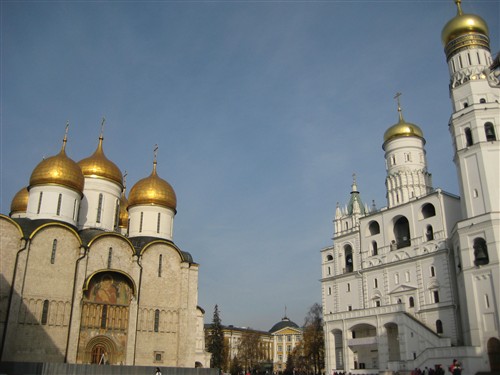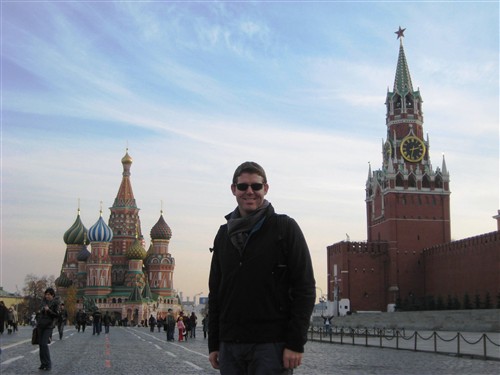Posted under Russia

Moscow. It is the capital city of the world’s largest country and the most populous metropolis in Europe. Home to the Kremlin and Red Square, it was the nerve center of Cold War communism for fifty years. The name Moscow alone elicits images of communist masterminds, KGB operatives and tales of international espionage. But that’s all ancient history. Finally, after years of post-Soviet growing pains, Moscow is the cosmopolitan core of one of the world’s fastest developing economies and a bastion of capitalism. With six days to go, we were excited to explore this last stop on our epic journey around the world.
 After nearly missing our train in St Petersburg – one of the very few times on the trip that we’ve been completely unprepared and, consequently, lost – we enjoyed the eight-hour journey and arrived in Moscow surprisingly rested. We easily navigated the metro system and found our cozy flat without trouble. Our friendly host, Tanya, gave us the grand tour of the small, two-bedroom apartment that we’d be sharing with another couple for the duration of our stay. Tanya was great, spoke wonderful English, and the flat was stocked with all of our favorite amenities.
After nearly missing our train in St Petersburg – one of the very few times on the trip that we’ve been completely unprepared and, consequently, lost – we enjoyed the eight-hour journey and arrived in Moscow surprisingly rested. We easily navigated the metro system and found our cozy flat without trouble. Our friendly host, Tanya, gave us the grand tour of the small, two-bedroom apartment that we’d be sharing with another couple for the duration of our stay. Tanya was great, spoke wonderful English, and the flat was stocked with all of our favorite amenities.
First on our agenda were, of course, the Kremlin and the adjacent Red Square. The Kremlin remains at the heart of Russian politics, a huge fortress complex in the middle of the city on the northern banks of the Moscow River. Kremlin simply means “citadel” in Russian and every medieval town had one; but none was larger than Moscow’s. Originally built in the 1150s, it became the headquarters of the Russian Orthodox Church in the early 14th century. At the end of the 15th century, Ivan the Great commissioned master builders to construct new walls, towers and three great cathedrals, creating much of the Kremlin that we see today. In 1918, at the beginning of the Russian Civil War, the Bolsheviks leader Lenin moved the capital back to Moscow, and the Kremlin became the nerve center of what would become the USSR.
 On approach, the Kremlin is striking. Tall red walls line the perimeter, the tops of onion-domed churches barely visible. In addition to the yellow and white government buildings that dominate the interior, there is an inexplicably out of place concrete and glass concert auditorium, and numerous beautiful cathedrals, each topped with glimmering golden domes. With most of the official buildings off-limits to visitors, we spent the majority of our time exploring the cathedrals within the Kremlin walls. We walked from one magnificent cathedral to another, first admiring the unique exterior architecture of each, and then the iconography that literally covered their interiors from floor to ceiling. Every artistic medium was beautifully represented: frescoed walls, carved and tempera-painted wooden icons, gilded silver iconostases, and marble tombs. We were mesmerized by the abundance of religious art.
On approach, the Kremlin is striking. Tall red walls line the perimeter, the tops of onion-domed churches barely visible. In addition to the yellow and white government buildings that dominate the interior, there is an inexplicably out of place concrete and glass concert auditorium, and numerous beautiful cathedrals, each topped with glimmering golden domes. With most of the official buildings off-limits to visitors, we spent the majority of our time exploring the cathedrals within the Kremlin walls. We walked from one magnificent cathedral to another, first admiring the unique exterior architecture of each, and then the iconography that literally covered their interiors from floor to ceiling. Every artistic medium was beautifully represented: frescoed walls, carved and tempera-painted wooden icons, gilded silver iconostases, and marble tombs. We were mesmerized by the abundance of religious art.
Red Square is surrounded by the State History Museum to the north, GUM shopping center to the east, St Basil’s Cathedral to the south and Lenin’s Mausoleum to the west. Passing metal barricades and baton-wielding policemen, we walked through the main entrance and under the Voskressensky Gates. Immediately, we spotted the ostentatiously colorful St Basil’s Cathedral ahead in the distance. We continued walking over the gray cobbled road, admiring the elaborate red façade of the State History Museum to our right and the beautiful Kazan Cathedral. With the afternoon sun illuminating the square, I wandered around, taking photos from every angle.
 We stopped in the middle of the square and looked around. More than two decades after perestroika, Gorbachev’s period of reform, there was still a palpable Cold War feel here that I couldn’t shake. Lenin’s mausoleum, still heavily guarded by soldiers, inexplicably remains a focal point on the square even after the failed experiment of communism. The massive wall and foreboding towers behind the mausoleum separate the Red Square from the Kremlin, a physical reminder of the Soviet Union, distinguishing the huddled masses from the powerful elite. Yet, incongruously, one of Russia’s finest luxury shopping malls shines like a beacon of capitalism no more than 200 meters away. And the boldly beautiful St Basil’s Cathedral is so awe-inspiring that you keep coming back to it again and again. Red Square is one big contrast – and I loved it. It’s big enough to exude power, but small enough to be intimate. On our trip we have seen many of the grandest plazas in the world but Red Square was, by far, my favorite.
We stopped in the middle of the square and looked around. More than two decades after perestroika, Gorbachev’s period of reform, there was still a palpable Cold War feel here that I couldn’t shake. Lenin’s mausoleum, still heavily guarded by soldiers, inexplicably remains a focal point on the square even after the failed experiment of communism. The massive wall and foreboding towers behind the mausoleum separate the Red Square from the Kremlin, a physical reminder of the Soviet Union, distinguishing the huddled masses from the powerful elite. Yet, incongruously, one of Russia’s finest luxury shopping malls shines like a beacon of capitalism no more than 200 meters away. And the boldly beautiful St Basil’s Cathedral is so awe-inspiring that you keep coming back to it again and again. Red Square is one big contrast – and I loved it. It’s big enough to exude power, but small enough to be intimate. On our trip we have seen many of the grandest plazas in the world but Red Square was, by far, my favorite.
One Response to “Last Stop: Moscow”

Andrew Leonard on 04 Nov 2008 at 9:50 am #
Congratulations!!!! I can’t believe to describe the envy I have for the two of you. I know that’s wrong, but to do something so incredible like you’ve done……who wouldn’t?!! It seems like only yesterday that we met as we were getting in a beat up taxi on our way to catch the midnight train. Oh…..good times indeed:)
I can’t wait to welcome you home and hear all the amazing stories! Safe journey home and can’t wait to see you! I’m taking you to the finest dinner…….McDonald’s 😉